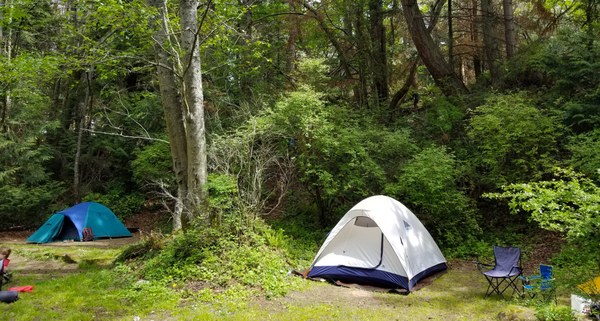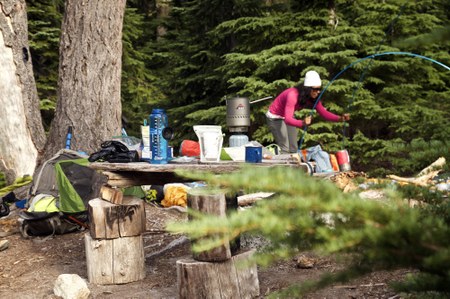
Are you excited to start testing the waters of outdoor adventure this summer, but not sure how to do it in a way that’s fun and safe for everyone? Consider car camping, the most accessible way to get outside overnight - making it a great way to introduce kids and trepidatious friends to the outdoors. To ensure your trip is successful and open the doors to future adventure, here are a few tips for brand-new car campers to take their trip to the next level:
Mountaineers Pioneers camping at Larrabee State Park. Photo by Carl Marrs.
Pick a Great Campsite
Carefully choosing a site that meets your group's needs is the first step in a creating a successful trip. Just because a place is beautiful or popular doesn’t mean that it’s right for you. A number of factors that come into play, and it’s important to identify your wants and needs before you arrive.
Campsites vary greatly in terms of amenities available; some have full showers while others offer only pit toilets. Talk to your fellow campers and see which of the below amenities are must-haves before you take the plunge into making a reservation:
- Access to running water or potable water
- Showers
- Fire pits (be sure to check for burn bans before going)
- Picnic tables
- Cancellation policies
- Dog policies
- Noise policies
- Privacy
- Access to shade (hot climates)
- Accessibility to nearby towns
- Cell reception
Of course, the environment surrounding the campsite is just as important as the site itself! Look into nearby hiking trails, biking trails, and lakes and rivers to see if the area fits your groups’ activity level and interests. Making a list of what’s nearby is a helpful way to keep everyone engaged once camp is set up.
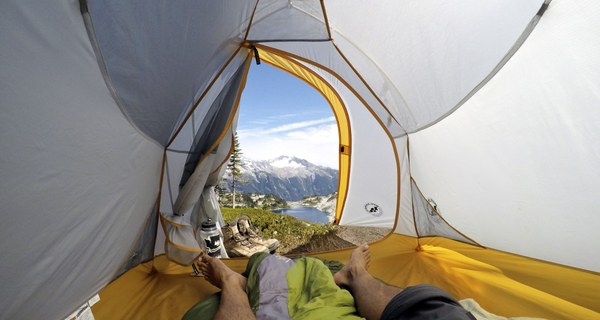 View from a tent at Hidden Lake. Photo by Rafael Godoi.
View from a tent at Hidden Lake. Photo by Rafael Godoi.
Get the Right Gear
When you’re car camping, you don’t have to worry about getting light-weight or high-tech gear, but it’s still important to have gear that will keep you warm, dry, and comfortable when you spend a night outdoors.
Make sure you have a good idea of the weather forecast and prepare for the wettest, coldest outcome – or worse. Having enough clothing and a warm sleeping bag to get you through an unexpectedly cold night and will save you the misery of lying in bed shivering for a few hours. If you're not sure what you might need, check out our blog on how to pick out a sleeping bag.
Waterproofing your tent is also a good idea if there is any chance of precipitation, and be sure to bring patching supplies along if your tent is older and might have a hidden hole or two. Most new tents will be reasonably waterproof already, but wet sleeping bags are no good.
Having a good sleeping pad is also a great way to stay warm and comfortable while you sleep. Keeping yourself off the ground and insulated is just as important as a warm sleeping bag to your overall comfort at night. Most car campers choose thick, cozy self-inflating pads because you are not hampered by size and weight restrictions. If you have a thin pad or if you wake up cold, place any extra layers (backpacks included) under your sleeping pad for extra insulation.
When you’re picking out a sleeping pad, keep its “R-value” in mind; this is a measure of its insulating power and warmth. The greater the R-value, the warmer the pad. Warm nights (50 degrees Fahrenheit or higher) can use a pad with an R-Value of 2 or lesser; cool nights (32-50 degrees) would do well to use a pad with an R-Value between 2 and 3.9; cold nights (>20-32 degrees) should use a pad with an R-Value of 4 or greater.
If you’re car camping in summer or a warm, dry climate, you can often buy or rent inexpensive gear that more than meets your needs. Expensive gear is not needed to have a great time outdoors. Just be careful to keep inclement weather in mind to avoid cold, wet nights.
If you want to borrow gear, check out our Gear Library. In light of COVID, we're now offering free personal gear rentals for Mountaineers members.
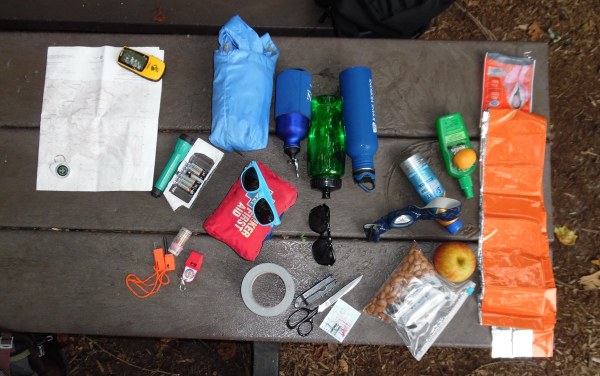 The ten essentials. image courtesy of the national parks service.
The ten essentials. image courtesy of the national parks service.
Get Organized
Make a List
Although it’s tempting to throw your entire garage in the back of the car, making a thoughtful list and sticking to it is key to a comfortable, successful trip. Over-packing can result in a crammed car that’s difficult to get things out of (or sit in), and under-packing can mean you leave key gear at home.
Start making your list at least a week before your camping trip; this gives you the opportunity to make thoughtful decisions and decreases the likelihood that you’ll forget an important item. Then, keep the list for the next time you go camping and don’t be afraid to add and take away from it – your sharpest knife or a cozy chair might be your favorite thing in camp, and well worth its space in the trunk.
Make sure all of your gear works and that you have backups for important items (like headlamp batteries and fire starter) before you go to avoid last-minute problems in camp. If you’re going far from home, keep the environment of your chosen site in mind. Is the region humid, windy, or buggy this time of year? If so, taking this into account as you pack can make the difference between a great trip and a miserable one. And as always, bring your Ten Essentials to make sure you and your group stay safe and prepared in camp or on hikes.
Pack Smart
Car camping is fun because you can bring favorite items from home that simply won’t make the cut on a backpacking trip – like big camp chairs, fluffy blankets, or a couple extra pairs of socks. However, jamming it into your car in a disorganized way can make setting up camp or accessing needed gear a headache.
Consider the order in which you’re going to be using things (you’ll probably set up your tent before you make dinner) and what will be staying in the car. This will help you avoid strewing the contents of your car all over your campsite as you set up. Pack neatly so that you know where everything is, and organize it in a way that makes sense – it’ll make searching for a late-night snack by headlamp that much easier. For ideas, check out this guide to elegantly cramming every last piece of gear into your car.
Plan Ahead
Bringing a list of nearby hikes and trails is a great way to keep everyone active and engaged on your trip. Be sure to note location, length, and elevation gain so that you can manage time and energy levels in a reasonable way. Having lots of options is always great, so over-prepare in this regard! Physical print-outs are great if you’re in an area with spotty cell service, and as always be sure to tell someone outside of the group where you’re going and how long you’ll be gone.
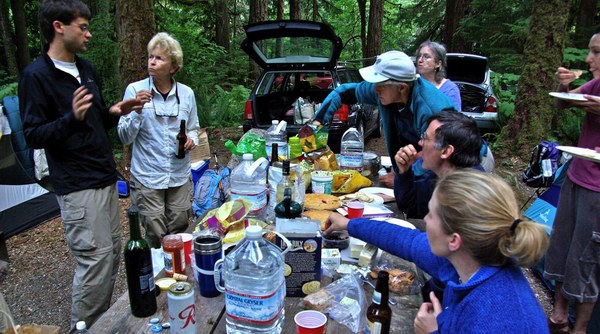 A camp-style buffet.
A camp-style buffet.
Focus on the Food
Some creature comforts are absent from a frontcountry campsite, but excellent food should not be one of them. As any backpacker will tell you, car camping’s biggest benefit is being able to pack a wide variety of fresh, tasty foods (and beverages). And when you’re away from home and work, why not take an hour to create a stellar meal to eat by the campfire?
Plan your meals so you can pack strategically and eat well while you’re unplugged. You don’t need a full kitchen to make a great meal; a camp stove, sturdy pan, and cutting board will get you far. Look at camp recipes like those in Mountaineer’s Books title Dirty Gourmet to find options for everyone. Fresh coffee, eggs, bacon, and flapjacks in the morning taste even better when you’re enjoying them outdoors.
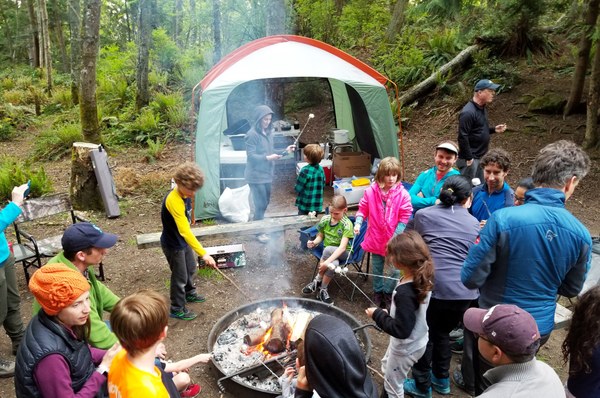 Pioneers camping at Larrabee State Park. Photo by Carl Marrs.
Pioneers camping at Larrabee State Park. Photo by Carl Marrs.
Have Fun!
Of course, the most important part of any camping trip is having fun! When we’re away from the distractions of home like work and television, it’s common for new campers to feel a little bored in between big planned activities. Bringing smaller activities along for the slower moments in camp is a great way to make sure everyone stays engaged, and helps kids see camping as a time for fun and play. Here are a few items you can add to your packing list to keep camp interesting:
- Books
- Card games
- Board games
- Camp crafts
- Binoculars
- Nature journal
- Inflatable boats and rafts (where appropriate)
- Bikes (where appropriate)
Car camping is a fantastic way to dip your toes into outdoor exploration without having to sacrifice too much comfort or proximity to town. With a little planning and foresight, you can turn a weekend into an outdoor adventure suitable for anyone.
Want to know more?
Below are a few resources to help you learn to make the most out of your camping adventures:
- Tent and Car Camper's Handbook: Advice for Families & First-Timers
- Dirty Gourmet: Food for Your Outdoor Adventures
- 5 Camping Hacks for Your Next Trip
- How to Knit in the Woods: 20 Projects for the Great Outdoors
- Don't Get Sick: The Hidden Dangers of Camping and Hiking
- Babes in the Woods: Hiking, Camping & Boating with Babies & Young Children
 The Mountaineers
The Mountaineers
